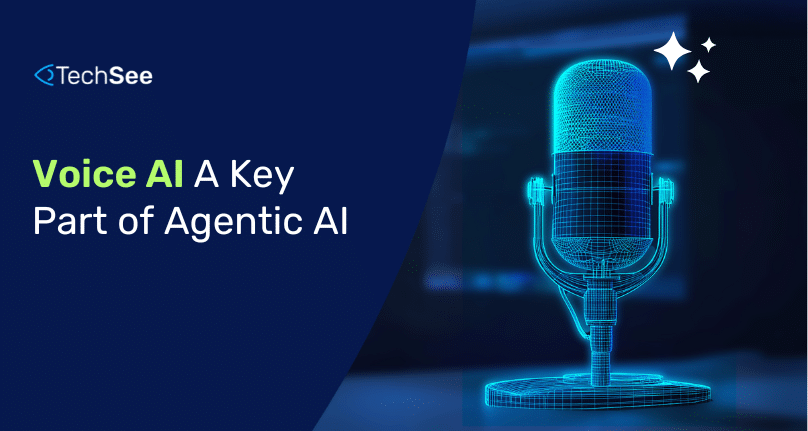Contents
Voice AI is rapidly becoming a powerful tool for scaling up and automating customer service, sales, and overall customer experience (CX). While this technology shows incredible promise, it should be integrated into a wider strategic conversation. Voice AI works best when combined with Visual AI and text-based AI, like large language models (LLMs), and action-oriented Agentic AI, as part of a broader multimodal AI automation strategy. By integrating these elements, businesses can deliver deeper context, richer interactions, and smarter automation across the customer lifecycle.
What Is Voice AI?
Voice AI uses artificial intelligence to process and respond to spoken language. It’s used to automate customer service conversations, help with troubleshooting, assist in product selection, and much more. But as important as this technology is, it’s only one part of a comprehensive AI-powered solution. In the age of multimodal agentic AI, Voice AI should be deployed alongside visual, data-driven, text-based, and action-oriented agentic AI to create a fully integrated system.
Why Multimodal Agentic AI?
Relying solely on one modality of AI—whether it’s voice, text, or vision—limits the potential and practicality the AI solution. Multimodal AI combines these different forms of intelligence, creating a holistic, context-aware, user-friendly experience. When Voice AI is combined with Visual AI, Data-Driven AI, LLMs, and AI action, it doesn’t just listen; it sees, reads, and understands in ways that provide more complete, accurate responses.
For example, imagine a customer support scenario where voice technology is taking a customer’s inquiry. By integrating Visual AI, the system can request an image or video to analyze the issue in real-time. At the same time, LLMs with a strong cognitive service can draw from product documentation, knowledge bases, or past service interactions to provide detailed, contextually relevant information. Furthermore, multimodal agentic AI can use augmented reality overlays and generative visual AI to guide the user visually. This is critical for tasks like setup and onboarding, This multifaceted approach delivers not only answers to common questions but actual problem resolution, the ultimate in Agentic AI.
Voice AI’s Role in Multimodal Agentic AI
This technology shines in environments where spoken communication is essential, such as over the phone. However, not every inquiry or customer interaction is best served by using voice alone. Think about all of those times that your elderly relative or neighbor has asked you for technical help with their WiFi, printer or computer. Often, because they lack the vocabulary to clearly articulate their setup and issue, it can be very difficult to guide them towards helping themselves. However, when that same elderly relative opens a screen-sharing session or starts a video call, and you can see the issue, helping them resolve the problem becomes infinitely easier. The same is true for AI.
Voice AI’s true power comes from working as an integrated part of a holistic AI solutions:
- Visual AI: Voice AI can guide a customer through a task, while Visual AI processes what the customer sees. For example, if a customer is troubleshooting a home appliance, the former can give instructions while the latter identifies the make and model, sees the root cause, guides them using augmented reality through the fix, and verifies if the issue is resolved. This enhances the precision and efficiency of customer interactions.
- Text-Based: LLMs are critical for adding contextual understanding to the conversation. Voice AI alone can capture what the customer says, but text-based models interpret and process meaning, drawing from vast datasets of customer service interactions, product knowledge, and FAQs. The fusion of these AIs ensures that the system delivers solutions, not just responses.
- Agentic AI: When Voice AI is integrated into agentic AI, it works autonomously to solve problems across multiple modalities. These AI agents, like Sophie AI, seamlessly combine voice, vision, and text to not only understand a user’s needs but to autonomously take action, making them the next evolution in service automation.
In Service and Sales
When positioned within a multimodal strategy, Voice AI excels at enhancing service and sales operations. In customer service, it can work in tandem with Visual AI, LLMs and Agentic AI as a frontline tool, quickly resolving Tier 1 inquiries and even tackling more complex issues. In sales, when working in tandem with visual AI, LLMs and Agentic AI, it assists in guiding customers through the buying journey, making recommendations, answering questions, and even facilitating purchases. These non-voice based modalities add deeper context, personalization, and clarity – while enabling Agentic AI actions enable the AI representative to complete actual purchases, just like a human agent would.
Often, customers who begin their journey with voice technology may need to switch modalities – adding visual capabilities to the previously voice-only interaction. Multimodal integrated solutions enable a smooth transition across text, voice and visual interactions, making service and sales experiences seamless and personalized.
Core Strategies for Deploying in a Multimodal Approach
- Start with Multimodal Context: When deploying Voice AI, ensure it is part of a comprehensive strategy that includes Visual AI and LLMs. This will provide your AI with the ability to switch between communication channels and types of intelligence, delivering more accurate and faster results.
- Use Voice AI as part of a MultiModal Approach to Troubleshooting Automation: Voice works alongside Visual AI in scenarios like technical support, where customers can describe their issue while uploading photos or videos, and receive similar voice, text and visual guidance towards resolution. These systems use visual, textual and verbal inputs to diagnose the problem accurately, and multimodal outputs to provide user-friendly guidance and resolution..
- Agentic AI for Autonomous Service: Multimodal AI agents, such as Sophie AI, can autonomously manage customer issues by integrating voice, text, and visual inputs. Deploying Voice AI as part of an agentic AI system ensures it doesn’t just respond to customers but solves problems and completes tasks across different channels.
- Automating Routine Sales and Service Tasks: Use Voice AI in tandem with Visual AI and LLMs to automate routine inquiries, like product troubleshooting, onboarding, or account setup. This not only reduces operational costs but also delivers a more efficient, dynamic customer experience.
The Future of Voice AI is Multimodal Agentic AI
Voice AI will continue to play a critical role in service automation and CX, but its greatest potential is unlocked when fused with other modalities. By integrating vision, text, and data-driven AI alongside voice, businesses can build a strategic AI-driven CX strategy. This multimodal agentic AI offers greater context, smarter automation, and more personalized interactions, which drive revenue growth, customer satisfaction, and operational efficiency.
At TechSee, we’re excited about the future of this amazing technology as a critical piece of the puzzle. Multimodal agentic AI—where Visual Intelligence and LLMs work together with voice—will drive the next wave of CX transformation. T
Schedule a demo today to see how Sophie AI’s multimodal agentic AI can take your organization to the next level.








